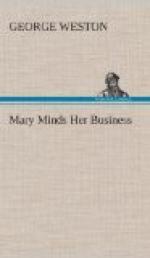She led them next to the kindergarten.
A recess was on and the children were out in the play-ground—some swinging, some sliding down the chutes, others playing in a merry-go-round which was pushed around by hand.
“Every other hour they have for play,” said Mary. “In the alternate hours the teachers read to them, talk to them, teach them their letters, teach them to sing and give them the regular kindergarten course. If they weren’t here,” she said, half turning to Professor Marsh, “most of them would probably be playing on the street.”
The next place they visited was the dining room—which occupied the upper floor of one of the great buildings which Mary’s father had planned. But to look at it, you would never have suspected the original purpose for which the place had been intended. It was a dining room that any hotel would be glad to call its own, with its forest-colour decorations, its growing palms and ferns on every side.
“The compartments around the walls are for the families,” explained Mary. “It is, of course, optional with those who work here whether they use the dining room or not. We supply all food at cost. This was this morning’s breakfast.”
The bill of fare is too long to quote in full, but the visitors noted that it included a choice of fruit, choice of cereal, choice of tea, coffee, milk or cocoa—and for the main dish, either fish, ham and eggs, oyster stew or small steak.
“What you have seen so far,” said Mary, “is a side issue. Many of our workers are young women not yet married, others have some one at home to look after the children. In fact the woman with a baby or little children is in the minority, but I thought it only right to provide for them—for a number of reasons—”
“Including sympathy?” smiled one of the ladies.
Mary gave her a grateful glance.
“We will now have an inspection of our real work here,” she said, “—the same being the manufacture of bearings.”
The first room they entered was the ground floor of one of the buildings which housed the automatic department. At the nearer machines were long lines of women stamping out the metal discs which held the balls and rollers in their places.
“When these machines were operated by men,” said Mary, “it required considerable strength to throw the levers. But by a very simple improvement we changed the machines so that the lightest touch on the handle is sufficient to do the work. We also put backs on the stools—and elbow rests—and racks for the feet—”
They followed her glances to each of these changes but their attention soon turned to the business-like speed and precision with which each woman did her work.
“Women, of course, are naturally quick,” said Mary as though reading their thoughts. “You know what they can do on a typewriter, for instance—or on a sewing machine. As you can see, it is much simpler to operate one of these automatic machines than it is to typewrite a legal document—or make a dress.”




